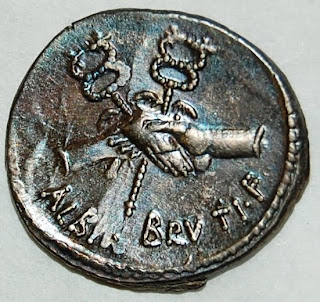A small piece of metal (FLAN) is placed between two surfaces that have the designs engraved on them. These are known are DIES. There is an obverse die that has the design for the "front" of the coin on it, and a reverse die that has the "back" of the coin on it. The flan is put between them and hit very hard - this is called striking the coin. Nowadays the process is entirely mechanised and several coins can be struck in quick succession. But in the past the process was carried out entirely by hand. The design was engraved into the die by hand, the flan cut by hand and the flan was hammered between the dies to make a coin.
Easy-peasy you may think. However, in order for the design to appear the right way up, it had to be engraved backwards onto the die. This is fine for pictures and so on, but the majority of coins include inscriptions of one kind or another, and writing backwards, legibly and artistically, is very difficult to do indeed. Furthermore, it's not called striking the coin for nothing - quite a lot of force is needed for the impression to be made evenly on both sides of the coin. Mistakes can sometimes happen ...
Look carefully at this denarius. It is a double-strike.
Look carefully at this denarius. It is a double-strike.
What has happened here is that the flan was struck twice, but between strokes moved around several degrees on the die. The female figure is not meant to have two faces. She is Pietas, the personification of duty to the state and the gods, not Janus (famously two-faced) and god of thresholds. On the reverse, there is only meant to be one caduceus (two snakes wrapped around a single staff).

All double-strikes are unique. So nowhere else in the world is there another denarius like this one.
Yet, double-striking is a fairly common mistake to find on coins, both ancient and modern, so not much extra value is added to the piece. For me, an extraordinary amount of value is added as this small coin shows us that mistakes from the past can still be seen today. Ancient people weren't perfect and in 48 BC a moneyer working in Rome messed up the design on a coin. It didn't effect the value and I'm sure this coin was circulated, but it is a very tangible way of connecting with the past. After all, mistakes are only human!
All double-strikes are unique. So nowhere else in the world is there another denarius like this one.
Yet, double-striking is a fairly common mistake to find on coins, both ancient and modern, so not much extra value is added to the piece. For me, an extraordinary amount of value is added as this small coin shows us that mistakes from the past can still be seen today. Ancient people weren't perfect and in 48 BC a moneyer working in Rome messed up the design on a coin. It didn't effect the value and I'm sure this coin was circulated, but it is a very tangible way of connecting with the past. After all, mistakes are only human!
Accession number: LEEDM.N.1854.0038.6137
Author: Lucy Moore, Leeds Museums and Galleries Intern 2010





No comments:
Post a Comment